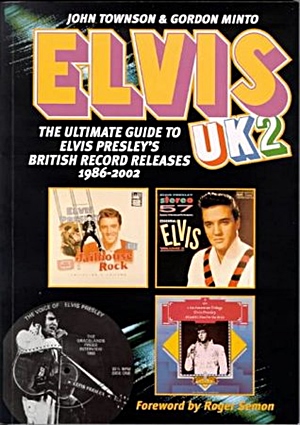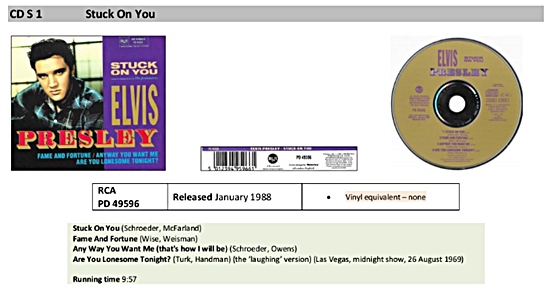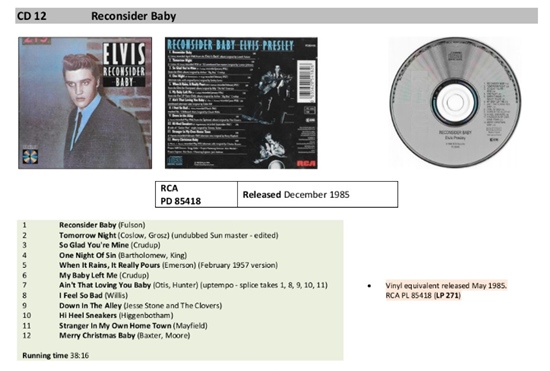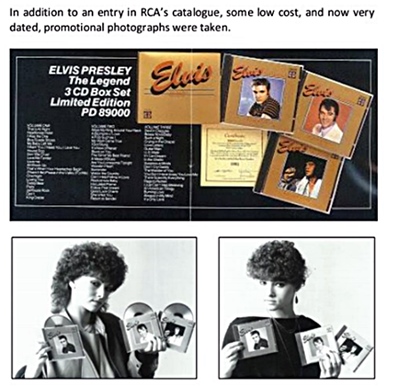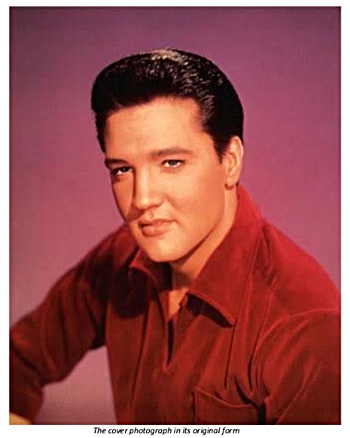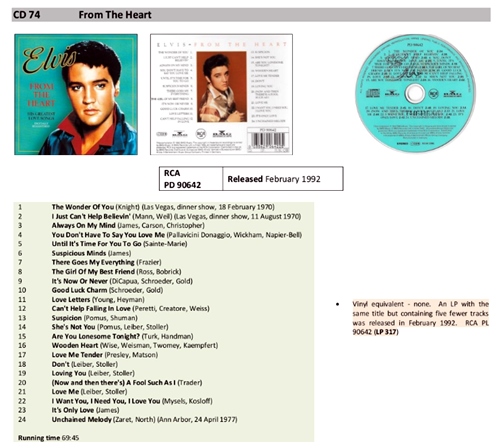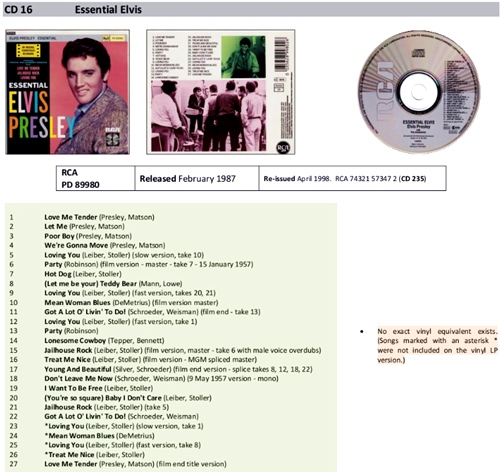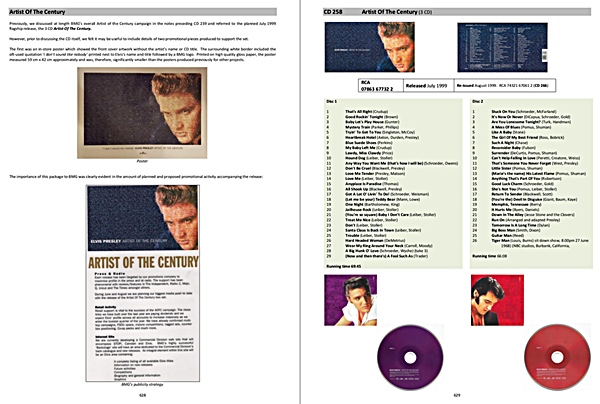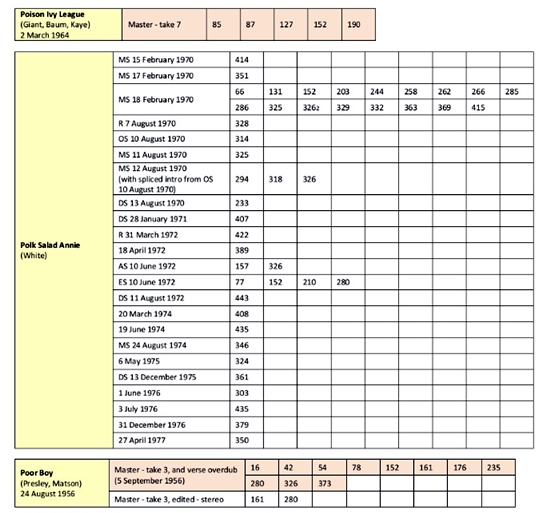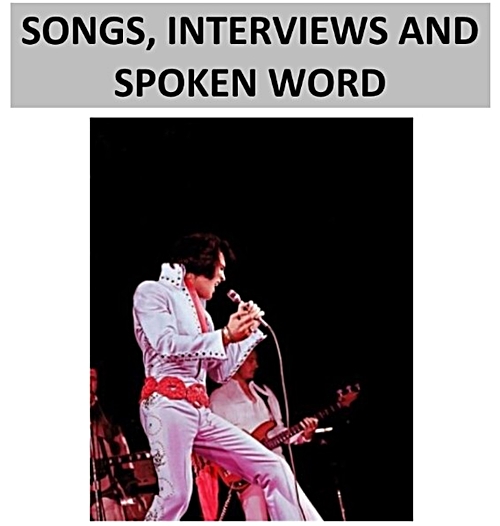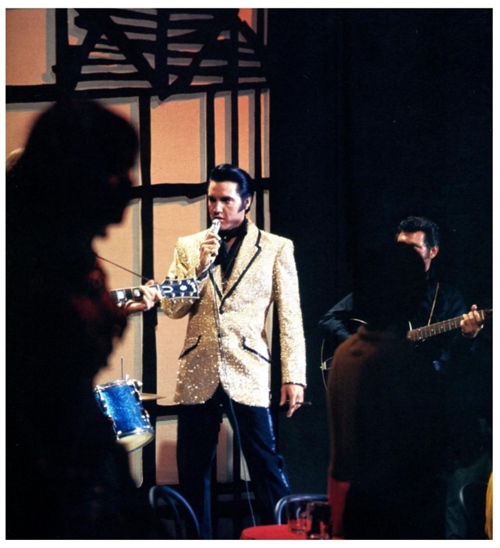 |
 |

Gordon Minto and John Townson authors of 'ELVIS UK 3' - interviewed by Piers Beagley March 2021 EIN : Firstly, congratulations to you and John on what must be the most detailed Elvis reference book yet published. I have been lucky enough to spend a few days luxuriating in your astonishing new publication, but EIN readers have been asking us a few questions about this new release. EIN: Let me start with asking that, with over a million words who is this book actually aimed at? J.T & G.M: - Thank you for inviting us to do this interview. As regards who our target audience is, principally, the book is aimed at serious collectors of both CD and vinyl - as for some time the two mediums overlapped - though we hope and believe that casual readers will enjoy and find the book of interest, too. And while the title implies that the book is solely confined to UK releases only, naturally there is considerable overlap with other major territories, especially once RCA / BMG started to take control and rationalise what had, up to that point, been a chaotic and random release policy by implementing a worldwide release programme. Therefore, although not listed as UK releases, we do make reference to other significant releases in other countries – for example, the German Book Club CDs, or the US version of Elvis For Everyone which was first issued on CD in 1990 but was actually the final back catalogue vinyl album from the 1960s to be reissued on CD in the rest of the world in 1994. That, we thought, was worthy of note and so included it. The same applies to a number of other similar releases. Of course, FTD releases are identical wherever you get them from. Many BMG titles may have different designs, but are, essentially, the same product.
EIN: It has been 18 years since the release of 'Elvis UK2', what took you so long! Life happening! At that time, we were both still working full time and it was not until 2015 – at which time we were both retired from full time employment - that we met (we actually live in different parts of the UK) to discuss resurrecting our ideas of producing a volume devoted to UK CD releases. Of course, we had kept in close contact throughout that period but were always niggled by the thought that there was some unfinished business. And by that I mean that originally, when researching and compiling Elvis UK2 (devoted to UK vinyl releases between 1986-2002), we envisaged a CD section running concurrently with the vinyl sections. Needless to say, owing to the rapid take off of CDs which threatened – and almost succeeded – in killing off mainstream vinyl releases, by 1989, in the midst of our research and writing, we concluded that it was almost impossible to run the two disparate things together as it would have led to an even bigger (and significantly more expensive) book. Thus, the CD section was filed away under ‘pending’. By 2015 though, we both felt that it would be worth revisiting this section especially as compact discs – once hailed as the saviour of the record industry back in the early 1980s – were themselves facing obsolescence in favour of digital downloads. This was not without some irony! And so, even though the medium was no longer the pre-eminent one, we believed that its impact on the music industry in general (and not just for Elvis, of course) was worth writing about in detail. And there’s no doubt in our minds that had CDs not been developed, then the music industry was facing a grim future and who knows how that would have impacted on the release of Elvis material, as the whole industry was in stagnation. The emergence of compact discs, therefore, was real shot in the arm of the music industry and allowed companies to revisit their own back catalogues and help rejuvenate the careers of innumerable artists, all of whom were anxious to get their work out there on this new medium – compact disc – not least because it generated much needed revenue for everyone concerned. It was win-win for all, and we discuss this important development at length, especially as it pertained to Elvis releases. What we didn’t expect was though that this project would become so all-consuming. Both previous works had taken some time to assemble but this one tops them all! From mid-2015 until mid-2020 we worked on this almost non-stop – even though we had technology on our side (the internet, emails and so on) and the facility to work and edit documents quickly and efficiently using word processing that wasn’t widely available to us previously.
A ten CD set from RCA Germany released as early as 1990 - who knew!
EIN: Do you think the book has an appeal outside the UK fan base? We do. And if the sales’ trend of Elvis UK3 continues its current pattern, then the answer is an unequivocal yes. Notably, thus far, a significant number of orders have come from overseas collectors, including countries such as Australia, USA, Brazil, Canada, France, Germany, Greece, Holland, Austria, Denmark, and Japan. And I suppose this goes back to a point we made earlier that, as RCA / BMG began to get its act together with regard to how best to present Elvis’s back catalogue (and by the way our negative view of the way Elvis product was handled for many years, is not just our opinion, but one expressed openly and honestly by many former company personnel) leading to a worldwide release programme being implemented, then hopefully a lot of what we have said about any given mainstream release may well be just as relevant to collectors in other regions. But regardless of that, as serious researchers / writers, we hope that our work reflects general as well as specific trends in music and we have always tried extremely hard to make our work not only interesting but accessible to our readers, irrespective of how devoted a fan they are or not. EIN : What surprised me is how it appears that the UK led the way for the rest of the Elvis World to follow. Do you think that was down to Roger Semon or the extraordinary popularity of Elvis in the UK? The likelihood is that it was a combination of several things. Over the years, the UK division of RCA tended to be more adventurous than many others and that trend only increased when Roger Semon - himself a lifelong fan who worked for the company from the early 1970s - then began to have some creative input into releases from around 1980. He went on to steer the release of a number of very innovative albums and, in 1982, persuaded RCA to release the two volumes of The EP Collection – both of which were hugely successful, both artistically, but also in terms of revenue generated for the company. It was a winning formula. But for these things to happen (and be successful) you a) had to have vision, b) a worthwhile and saleable product and, c) a receptive market – and in that regard, the UK has always been very loyal to Elvis, much more so than in the USA, we would argue. Therefore, it was no real surprise that Semon’s creative marketing skills were put to increasingly good use and that he – as many former company personnel repeatedly told us – became the in-house Elvis expert and the go-to guy at RCA. It was Semon who was approached / directed by senior executives at RCA in the UK to compile the very first Elvis CD in the world, back in 1983 – a 3 CD set no less! And let’s not forget that BMG in the UK released ‘Stuck On You’ - which was the very first Elvis CD single in the world too - in January 1988.
EIN: In researching the book do you think you learnt particular new insights into RCA's marketing on Elvis? Well, yes and no. It was a fascinating study and one we enjoyed researching. The marketing theme runs like an artery throughout our narrative, right from late 1983, when the first Elvis CD in the world was issued in the UK, and onwards. However, what was manifestly clear to most fans / collectors in the period of time following Elvis’s death was that RCA’s response to that tragic loss was chaotic and woefully inadequate – with one or two notable exceptions (for example, the Elvis Aron Presley 8 LP set in 1980). In short, there was little to no overall coherence in how Elvis product (in whatever form it took) was marketed anywhere in the world – something which the introduction of compact disc exposed even further. The Elvis scene, in terms of record releases – with some notable exceptions - was generally dismal and uninspiring. This was still the case a few years later when the most significant technical advancement in the music industry for many years – the invention of the revolutionary compact disc - occurred in the early 1980s. RCA was still in the doldrums and had no clear or collective direction for the Elvis catalogue. Album releases were random and ill-conceived but, even more depressingly, they failed to sell in any appreciable numbers. In effect, the company had lost interest in its premier artist. And it came as no surprise to learn from previous employees of the company that this was their view too! Then around 1984, Gregg Geller joined RCA in the USA and, although his remit did not include anything to do with Elvis at all, almost accidentally, he became involved in the Presley back catalogue when the original concept of A Golden Celebration came to his attention. Dismayed by what he saw as wasted opportunities, he took his concerns higher in the company and then set about modifying and beefing up the set, though in doing so incurred the wrath of old-timers like Joan Deary who, up to that point, had enjoyed a free hand to do whatever she wanted with the Presley catalogue – principally because no one else in the company was interested in being involved! Alongside his other main duties, Geller tried manfully to re-invigorate the back catalogue, though this met with a with mixed response (Rocker, A Valentine Gift For You, Always On My Mind and his own favourite – Reconsider Baby) though he also produced several landmark albums such as The Complete Sun Sessions and The Memphis Record before moving on in 1987. Incidentally, his direct and candid personal input to us regarding events during that era was also fascinating.
Later, as new personnel joined the company – and here we would cite the example of Mike Omansky in the mid-1990s – the company’s focus on marketing sharpened considerably. Omansky, for instance, as a highly skilled marketing executive, trusted Jorgensen and Semon to generate innovative releases (as they had been doing very successfully since the late 1980s) but he also sought out new markets, such as QVC, which earned huge revenue for the company. And here, perhaps, it is worth reminding everyone of one simple fact: the company – whether it was RCA, BMG or now, Sony – exists to make money and, not surprisingly, tries to exploit, in a very legitimate way, both new artists and its roster of back catalogue artists. To do otherwise would be foolish and negligent. The only argument comes when trying to determine at what point exploiting the market becomes excessive and counter-productive. So, while the release of compilation albums may well have irked dedicated collectors at times (ourselves included, in all likelihood) who complained ‘same old, same old’, it was the success of many of these big sellers that a) kept Elvis’s name in the public consciousness and, b) provided a lot of the revenue to fund more fan-focused releases that responded to the seemingly never-ending appetite for something different, but which only appealed to a much smaller audience. And, of course, with respect to the question of repetition, the killer riposte from the company’s point of view was: this release is not targeted at you – you don’t have to buy it if you don’t like it. But with consummate irony, many of us did buy these things, repeatedly! EIN : Are RCA / BMG / SONY right in continuously pumping out Elvis product - and yet more "Greatest Hits" - or should they have stuck to 'The Beatles' approach of only one essential release per year? Again, opinions are divided about this issue and many people would argue that RCA / BMG saturated the market which is never a sensible or sustainable marketing policy. But two things jump out here. First of all, we would refer you back to our previous answer about a company’s right to market its product as it sees fit – though that policy may not sit comfortably with many fans – and secondly, we have to mention that the relative size of the back catalogues for The Beatles and Elvis are very different. Furthermore though, two of the Beatles are still alive (three when CDs were first developed) and had (indeed, still have) a right to make their views known to EMI and help influence policy. That is not the case for Elvis. No one was batting in his corner for a number of years, especially after the falling out between EPE and RCA who had slugged it out in court in an unseemly way in the early 1980s. Therefore, in the early days of CDs, EPE was not consulted at all. It was only later when overtures were made to EPE outlining the mutual benefits there were for both parties if they worked together that real change took place. And while Elvis’s first CD appeared in 1983 (actually a 3 CD boxed set!) EMI did not issue any Beatles’ material on CD until 1987. So, trying to give a definitive answer as to whether or not the companies were right to issue so much Presley material is tricky. What isn’t at issue though is that they do have the right to do so. It’s a neat distinction. And, of course, in more recent times the number of mainstream releases has slowedconsiderably (especially since the contentious RPO releases – ‘marmite albums’ as we like to think of them - seem to have run their course), although FTD releases continue unabated, though the label is thought to be serving an ever-diminishing market.
EIN : To be honest, while I thought I knew my Elvis releases it had not occurred to me that ‘The Legend' was the first Elvis CD release and how much thought and process had to go into this stunning first 1983 "deluxe" set. Producing CDs now is so easy, yet back then it was a labour of love. With so many subpar Elvis releases that followed did it surprise you that so much work went into that first release? Again, this comes down to the people involved and their collective drive and motivation at the time. And yes, perhaps love did come into it, but what we also learned was that team – led by RCA VP Alan Cornish, Greg Rogers (Marketing Director) and Rob Davison (CD Manufacturing Controller) – was not only driven by commercial concerns but also a degree of healthy rivalry too. Despite serious time constraints and capacity issues, they were dedicated to producing a quality item that would become a collectors’ release - and also be the first RCA division in the world to do so, thus stealing a march on the US division and earning kudos for the UK / European office. They succeeded all on all counts. Certainly, what did surprise us was the short time-frame they had to produce this set (said to be three months) and how bringing all the components of the set together occurred. It is a subject we discuss at great length in the book and rightly so for it was a seminal moment for the medium. Undeniably, we have to pay tribute to the able assistance of Rob Davison, whose own blog - pickedmix.blogspot.com - proved to be of enormous help to us and who, once contacted, helped clarify the intricacies of RCA at the time as well as allowing us to use photos taken at the time The Legend was launched. We are also grateful for the wonderful help given by Greg Rogers who headed up the European office at the time. These folks were unstintingly supportive and spoke to us many times, answering all of our questions honestly. EIN : I was still a vinyl buyer in those days, unless a CD offered me more there seemed little reason to go to something so "Intangible". With your book UK2 being about vinyl, at what point did you decide Elvis CDs might be worth collecting? During the closing stages of our writing of Elvis UK The Ultimate Guide To Elvis Presley’s British Record Releases 1956-1986 (our original book) and it being prepared for publication, CDs started appearing but were still very much a niche part of the music market at that time and so only rated a small reference in that volume. However, when we began our follow up – Elvis UK2 – sometime in the 1990s, CDs had become the pre-eminent medium for accessing music and so it seemed right to include them, especially as all the signs were that vinyl was about to emit its last dying breath – and certainly had become a narrow interest for all but the most-dedicated vinyl collector. But as we said earlier, the sheer volume of material that we had amassed in a very short time and the task of running a CD section concurrently became unsustainable (for reasons of space). Therefore, we set aside that section in favour of what we thought then would be the end of vinyl collecting on any major scale. As for collecting CDs, that only occurred once the hardware became more affordable and then it was down to the business of backtracking in order to collect the early CD releases. We were lured, as many people were, by the alleged superior sound of compact disc (though that turned out to be a fallacy, for reasons we also discuss) though their ease of use was undeniable. And so, as many collectors did, we routinely bought both major formats – just as the companies hoped we would! Ker-ching! Ker-ching!
'Fun In Acapulco' - EIN had never previously noticed that the front cover photo had been flipped
EIN : Is your house laden down with every CD release featured in the book? It’s fair to say that between us we have quite a few … though many of the various artist and ‘cheapos’ were – and still are – difficult to track down. And, somewhat ironically, it is this fact that makes them collectible in some people’s minds, despite their obvious limitations! As we readily concede, the business of collecting is not necessarily a rational thing … EIN : How on earth did you, and John, keep track of every CD release over the years, there seems to be "Too Much" to get one's head around? Truthfully, the mainstream releases (and FTDs) were fairly straightforward to keep track of as we bought them as they were released and noted them at the time. The tricky ones to trace and understand were the ‘cheapos’ - referred to above – and some of the various artist collections. Many collectors may wonder why we included the former as they were usually – though not always - low priced, low quality items. However, they were legitimate releases – a genuine, albeit often grubby, part of what was available - and deserved to be included for the sake of completeness, even though they tended to feature pretty much the same unofficial live recordings from the 1954-56 period – the ownership of which was blurred which allowed anyone who cared to issue it . Unfortunately, because of their ‘here-today-gone-tomorrow’ nature, most regular music outlets did not stock these items which were usually found in non-traditional stores or market stalls. And when we contacted some of the companies involved, it became blindingly obvious that quite often they did not remember (nor had they logged) when these releases first appeared, nor did they seem to know where the material had come from. And so, inevitably, the same level of incompetence plagued many of these releases whereby incorrect recording dates were shown - along with erroneous track information and lousy edits etc. - time and time again!
EIN : I particularly enjoy the side discussions like stories about Boppin' Bob Jones, RCA's Lee Simmonds and the 'From The Heart' album (his influence on making 70 minute value-for-money compilations, I knew nothing of this), lots about Roger Semon and Ernst Jorgensen's work, Behind-The-Scenes details on FTD releases, a nice discussion about "Fake News" ie RCA incorrect release info and promotion and even leaked bootleg releases etc etc. How on earth did you decide what needed to be included? That’s very encouraging to hear your comments about that as we believe that is what gives the book another dimension and lends it depth and interest. Despite what some people may think or say, this is categorically not a discography at all but a serious attempt to chronicle faithfully and accurately the historical development of a major breakthrough in the world of music – as it applied to the Elvis Presley catalogue, of course – and offer some serious analysis of what we found in order to better understand it ourselves and then share our findings and thoughts with a wider audience. As for what to include and exclude, throughout the research and writing of both Elvis UK2 and Elvis UK3, we applied the same principle whenever we wondered what to include. We’ve said this before, but the real art of writing the history of anything is not simply putting everything you can think of in but knowing what you can safely leave out. It’s a question of judgement. Broadly speaking, when discussing inclusions and exclusions, our approach was to ask ourselves a couple of simple questions: a) is it interesting and relevant and, b) as serious collectors, would we like to read this kind of thing ourselves? Our answers to those questions shaped our decision regarding content. I suppose the final point to make on this question is that, like our previous works, we always tried to avoid speculation and only included things we have actually seen or have been verified to our satisfaction.
EIN: I was actually surprised that "Essential Elvis" (Vol 1) was the 16th CD released. At least I remember seeing that on CD and Vinyl and knowing that there was more on the CD version. With 'Essential Elvis Stereo '57' two years afterwards (CD 39) were fans truly aware of the importance of these releases? After all there were 23 CD releases between these two gems? Notwithstanding the random nature of some of those early CD releases, this was a fascinating period to look back on and discuss. Without question though, the Essential Elvis LP released in December 1986 (the CD containing more material was issued in early 1987) was a pivotal moment in the Elvis catalogue, even though nowadays it looks quite tame compared with some later releases. Devised, compiled and manufactured in the UK (another first), it was a major collaboration of a number of various interested parties, co-ordinated by Roger Semon but involving people like Todd Slaughter of the UK fan club and, for the first time, one Ernst Mikael Jorgensen. It was a wonderful release and set the scene for many more like it and yet, notably, this ground-breaking album did not secure a US release until 1988! The follow-up, Stereo 57 was arguably even more important as it was the first time tapes of complete Elvis sessions had been allowed out of the US to be mastered in the UK by the legendary Boppin’ Bob Jones who, by this time, was a very close friend of ours. And add to that the fact these were binaural tapes, long lost and thought to have been thrown away … Fantastic! EIN: In terms of CD releases do you consider 'The King Of Rock n Roll' box-set as the true turning point? In short, yes. Certainly, there had been some wonderfully imaginative releases prior to this (the first three volumes of Essential Elvis, for example), but the concept for the ‘50s set was truly bold and ground-breaking, not only for Elvis, but for the producers (Roger and Ernst) and the company. Again, the background to this release is fascinating. Without question, it not only established and confirmed the credentials of the two producers, but also helped to rehabilitate Elvis’s reputation as a serious artist. By comparison, the 3 CD / LP set Collectors Gold, issued in 1991, although welcome, was a much more tentative and modest release, produced on a very tight budget – and it showed!
EIN : July 1999 FTD's first release 'Burbank '68', plus the "Artist Of The Century" mainstream set, as an Elvis music fanatic this changed my life. What was your reaction as a long-term collector, could the future look any better at this point for collectors? The mid-to-late 1990s was a sort of golden age for many fans and BMG issued many excellent releases, as well as upgrading a lot of back catalogue stuff. Ambition seemed to be the watch-word and what was abundantly clear to us was that the company was pursuing coherent and relevant strategies on a number of different fronts, thus appealing to a wide cross-section of the public. The market was awash with Elvis product but unusually, it was all of a very high quality, even the so-called budget releases. The creative energy came from Semon and Jorgensen (who by this time were consultants, of course) but the clout to do these things – including the setting up of the Follow That Dream label in 1999 – was provided by the likes of Mike Omansky in the USA and Klaus Schmalenbach in Germany. With the impending release of Artist Of The Century, things looked very bright as the new millennium approached . The Elvis catalogue was in good shape with an attractive range of product for every niche in the market, including the serious collector as FTD had come on stream in 1999 – another development that we have discussed in great detail. And, of course, as FTD’s remit was to cater for the collectors’ market, inevitably this impacted on mainstream releases which started to focus much more on the general market. EIN : How many new interviews did you do for the book or was it all based on previous research? While we can’t say precisely how many we conducted – there were quite a lot over a long period of time. However, much of what we wrote about was from our own experience and research, but we also had invaluable assistance from a number of individuals (all duly listed and credited in the introduction) who went out of their way to be helpful and grant us interviews, predominantly during numerous and long telephone calls and email exchanges. And while we did learn a lot from each person we spoke with, equally it was reassuring that much of what they told us simply corroborated theories we had developed - or offered us a different or alternative perspective. Notably, when speaking with various former employees of the company (RCA or BMG), they all spoke frankly and openly about their experience. EIN : What new discoveries and delights did you uncover in your research for the book? There are really too many to bring to mind right now but it was wonderful to track the development of compact discs and note how the packaging and general presentation began to improve over time – even though sometimes, the CD in question did not include the track or version listed on the actual CD. Also, the mastering techniques improved considerably, especially when the original source tapes were located and used. And while production errors are astonishingly rare (unlike vinyl, when they were common) they do exist – with label information missing and so on. Additionally, as time wore on, there were serious attempts to offer fans / collectors better value for money and lower costs.
One of the many cross-reference tables showing what versions of each song was released on which CD.
EIN : What is your favourite section of the book? Gordon: I can’t identify one in particular, but I really like the tables – and there are many which appear throughout the book at various points – and the sidebar comments, which appeal to me very much. They look good and are packed with interesting and relevant information. We also find ourselves quite amazed when re-reading something that we had forgotten about – even though we had written it in the first place! The song index too – which not only cross-references where each song version can be found – but also delineates where the outtakes are is especially informative and helpful. We are proud of that.
EIN : It is a MASSIVE book - which I have only had a little time to dip into. You even go into Elvis' Interviews and Spoken Word releases, promo releases and more... at what point did you decide it had to be a digital release and not a hard-back? Our aim from the outset had been to try to produce a physical book, but about six months ago, as the text was finally completed and we had edited and re-edited our material, we realised just how big this thing was and how many pages we had ramped up (1402!) We then turned to the serious issue of how to get it published, though some may question why we did not do this earlier. Let us explain. It is worth re-stating that we are two individuals who have been working on a major project for almost six years – no one commissioned us to do this and so we had total control of our project throughout and an entirely freehand in deciding every aspect of it, including the way it was designed and laid out, as well as what went into it. That’s a rare luxury for any writers. Therefore, when considering the issue of publishing, we explored many options. Sadly, though, our foray into the physical book market led us to the inescapable conclusion that trying to get our work published in a conventional way was simply unaffordable. At 1400 A4 pages, the cost of producing even a few hundred softback copies was staggeringly expensive (not to mention incurring crippling postage rates) and so virtually ruling out any overseas sales. Regrettably, those who blithely ask, ‘why didn’t they just do a few hundred copies?’ reveal a complete lack of understanding with respect to the economics of the situation, for the financial outlay would have been truly ruinous for anyone to undertake. There’s no point in quoting figures here, but suffice to say that many of the alternatives that people have suggested we try simply did not have the capability to cater for such a huge project – even one that would have run to at least two or maybe even three volumes. Therefore, our choice was simple: weighing up the options, a stark choice faced us: it was either opt for a digital release or, alternatively, abort the project. As our friend, Keith Flynn, had used Flip successfully for the digital version of Ultimate Elvis a few years ago, this is the medium we decided on – though we were very well aware of how that would be viewed by some who would have preferred a physical product. And while we are not unsympathetic to that view, it all comes down to harsh practicalities as we mentioned earlier. But, in our view, having decided to use Flip we were truly amazed at how intuitive the programme is and how well it lends itself to this kind of reference book. It is much easier and quicker to access and flip through than any conventional book - and that’s not a sales’ line, by the way, it is a fact, and one attested to by many of the users so far - even those who were sceptical about whether or not they would take to it. Incidentally, it may be worth mentioning that for those who wish to do so, there is an option to print hard copies of whatever pages you might want in that format. EIN: Why a Flip-book and not for instance Kindle? Ultimately, it came down to choosing what we thought was the best digital medium available to us. A kindle edition may have reached more people, perhaps, via Amazon, but aren’t kindles only in monochrome? And one thing we are completely delighted about is being able to use full colour in this book, unlike our previous works. The contrast in appearance is startling. Additionally, kindle doesn’t offer anything like the amount of great navigational facilities that Flip does. EIN : As a flip-book are purchasers guaranteed that it will always be accessible? At a risk of repeating what we have already said, while we understand why some people may feel uncomfortable about not having a physical product to look at or hold in their hands, our belief is that, like many other subscription services available today, we are committed to ensuring that our loyal customers have access to the material as long as they wish to. Self-evidently, it is in our interests to maintain this service for existing as well as future customers. But can we guarantee it may never be interrupted? No, but nor can any other of the major companies such as Netflix or Spotify. However, any break in service is usually rare and very short-lived. A clear advantage of Flip is that whenever we make any changes to the text that will be the version that everyone accesses whenever they received the access links. And finally, we can assure subscribers that we have the book well and truly backed up.
EIN : Personally, I do like having reference books with me if I am on holiday, so the format works for me and the photos look glorious. Plenty of "rarer" images used within the book, so how did you go about choosing them and who did the layout and design? Glad you like some of the rarer images used in the book. We do too! And though this book is definitely not a photo-journal, it was important to us to include some attractive images and we are very grateful for those who kindly agreed to let us use their photos. Special thanks must go to Tony King in the US for allowing us access to some very unusual and high quality images. Everything that appears - our choices of images / text etc. - was agreed by both us, as was developing the layout and design of the book. As for the front cover, we were very keen to link with the two previous volumes – as it sitsalongside those very comfortably - and this was achieved, we think. EIN : How has the response been so far? The response so far from people who have either bought it or checked it out has been phenomenally positive – in fact, embarrassingly so. The reviews on our site are wonderfully complimentary, including comments from some of the former company personnel we interviewed, which took us a little aback. While we hoped that they would be pleased by what they saw, we were not expecting such an effusive and enthusiastic response. Nonetheless, it has been extremely gratifying to read their comments and to know that we had represented what they said in a fair and accurate way. Significantly, the only criticisms we have heard have come from folks who haven’t seen or tried it the book. That tells its own story, we think. Undeniably though, we are aware that some people are hesitant about committing themselves to what is a new way of publishing and we understand that this relates to apprehension about technology, but we think it’s also about consumer confidence too. What we would say is that everyone who has bought a copy thus far has not only commented on the amount of detail included, but how extremely easy it is to navigate through the book and find what you are looking for in seconds. The built-in search facility is great and the contents (located in the sidebar) extremely comprehensive. You can get to a particular section or find a CD or person within seconds. EIN: is there anyway anyone can publish a follow up, because once the EU Public Domain release started the Elvis CD releases went berserk? It would be a challenge, that’s for sure!
Please note that the low-res screen grabs used do not show the true quality of the images Interview by Piers Beagley. Click here to comment on this INTERVIEW Go here to 'ELVIS UK 3' website to check out more preview pages - and independent reviews
EIN Website content © Copyright the Elvis Information Network.
Elvis Presley, Elvis and Graceland are trademarks of Elvis Presley Enterprises. The Elvis Information Network has been running since 1986 and is an EPE officially recognised Elvis fan club.
|
|


